OFF-TOPIC (51)
By:
July 12, 2023
Off-Topic brings you over-the-transom, on-tangent essays, dialogues and subjective scholarship on an occasional, impulsive basis. This time, to bookend yesterday’s wide-angle account of the 2023 gathering in Bowie’s name, a close-focus conversation with his right hand and brains-of-the-outfit…
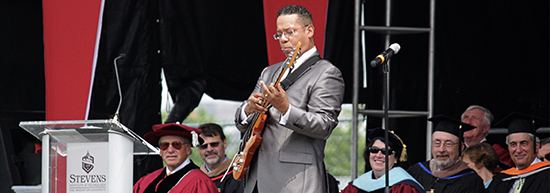
That’s Professor Guitar God to you, son: I knew I had booked a brief session of office-hours with a legend I would learn a lot from, and the first fun fact I did not see coming was that Carlos Alomar, iconic co-creator and longrunning bandleader for much of my favorite David Bowie records and concerts, was also now Artist in Residence at Stevens Institute of Technology’s College of Arts and Letters in Hoboken, NJ, as well as Founder/Director of Stevens’ Sound Synthesis Research Center (S.S.R.C.).
The co-architect (with bassist George Murray and drummer Dennis Davis) of Bowie’s bedrock sound from Station to Station through Scary Monsters, and his musical director for even longer (through Let’s Dance’s tour and both tour and album for Never Let Me Down), Alomar is the quintessential go-to maestro for more artists and bands than I can list (so you’ll see him list some below); adept in all styles and unmatched in his invention and integrity.
A serene presence, spellbinding storyteller and slyly hilarious philosopher, Alomar sat down for a short one-man seminar during a break on day one of the 2023 David Bowie World Fan Convention…
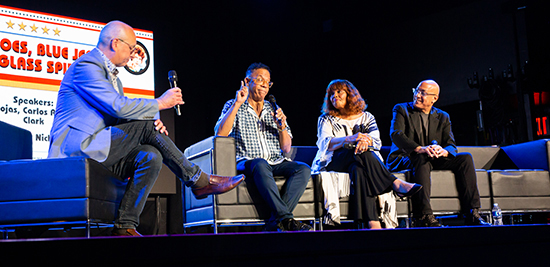
HILOBROW: One on panel you were talking about the genesis of “Golden Years,” and how it began as a chord progression, and y’all started to embellish on it. Since the theme and lyric weren’t yet known, is it just a myth that Bowie had conceived that song as something to offer to Elvis Presley?
ALOMAR: No idea — you’ve gotta ask the person that wrote it [laughter]. Objectively speaking, Elvis was definitely on his mind, and many times when he was thinking about how he was going to deliver a song, Elvis definitely [came] to mind. As a singer you look at certain shapes that allow you to sing certain things. Let’s say you’re thinking of Aretha Franklin or Whitney Houston, you better have a lot of curls in that voice, you better be able to do those vocal acrobatics. And if you want to have something compassionate and slow, then you’re going to imitate someone. So whether it was Presley, interpretively speaking, someone might reflect, and assume, that that might be so. But I certainly couldn’t verify something like that. Though even Elvis can become a muse.
HILOBROW: The way you describe it fits into the projection of himself into a role that Bowie always professed was his way of performing without anxiety.
ALOMAR: Exactly right. Be another persona, and then that will take care of itself.
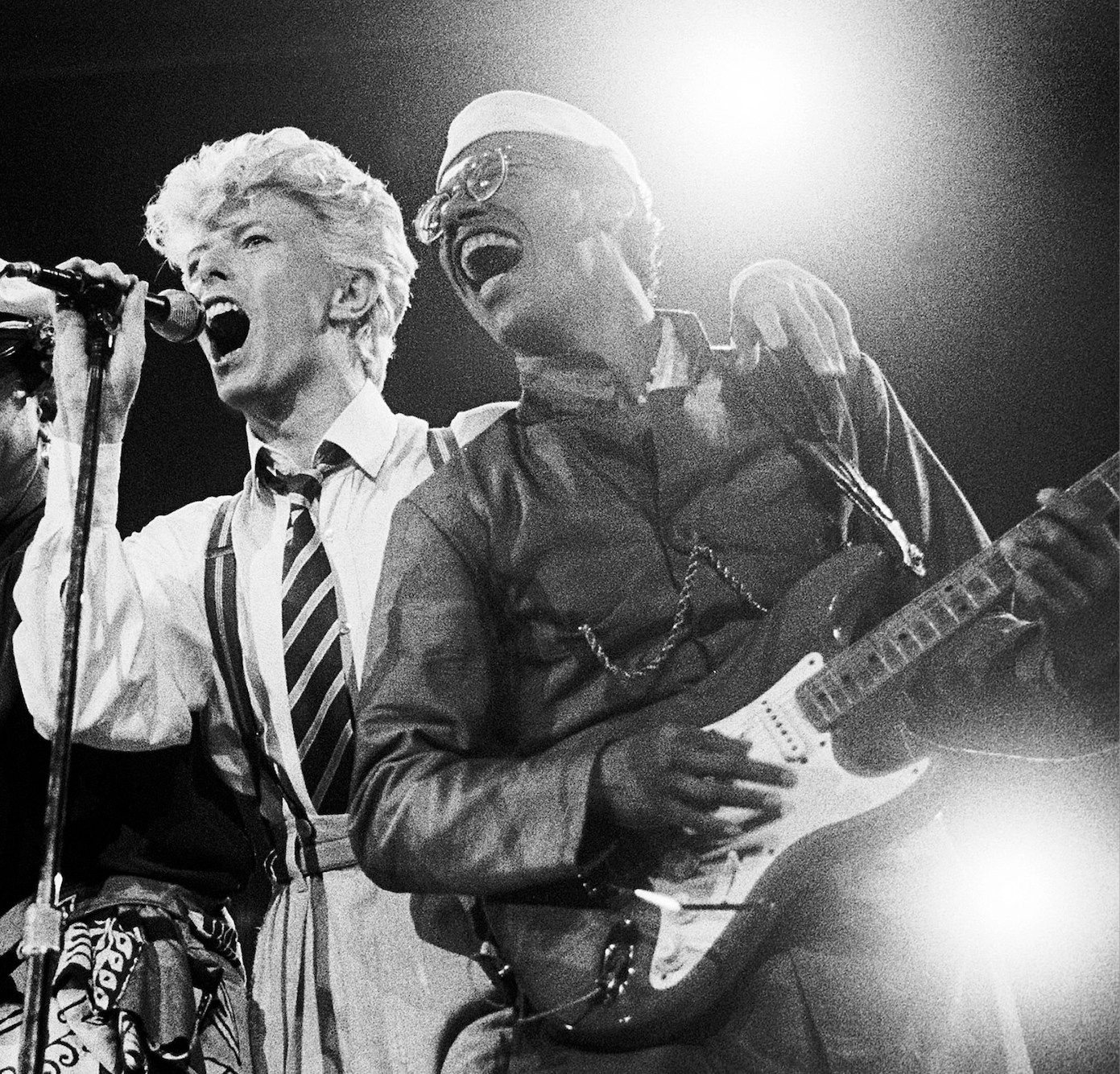
HILOBROW: You are one of many Bowie collaborators today who have spoken appreciatively of being given the freedom to co-create, to find your way into each song, and [of] how you knew the music was going to be something different every time, from song to song and certainly from album to album. The times when you didn’t get the call to be on an album or a tour, did you accept that as part of the right-style-for-the-right-setting kind of thing, or—
ALOMAR: Ab-solute-ly NOT [laughter]. My…number one: In order to be happy, you must be grateful. It will lead you to a simpler life; it’s very very easy to be happy. And so I do not expect any phonecalls from anyone. The minute I get a phonecall, I am very happy. The fact that I don’t expect anything makes it very easy to be happy. The fact that I was called back [after] Young Americans, I was shocked. When I did Young Americans I did three other albums for somebody else; every time I’ve done one album for David I have done at least three, and my wife [Robin Clark] maybe four albums for somebody else. I have been recording since 1969, ’til now. I just finished doing Alicia Keyes, I did Uptown Special with Mark Ronson; I’m still current. So, there is no expectation of getting a call, there is no “why did he do that to me” or “he owes me”; none of that. It’s not a proper way in order for you to feel happy. And so, if you just lower those expectations then you will be greatly rewarded. So I really don’t have those expectations, and I don’t obligate anyone. I have my happiness, and it has nothing to do with the music industry.
HILOBROW: It’s like the Buddhist idea of no attachments; this is like not getting attached to something that hasn’t even happened yet.
ALOMAR: Well, a means to an end is important, because we must all eat, we must all raise our children and we must all give ourselves a quality of life we can respect. But that being said, we don’t have to go to certain levels to get it! Desperation is not a proper vehicle, it will never get you where you wanna go — you’ll probably go a thousand miles an hour in the wrong direction. So for me, I’m very very grateful of the fact that I don’t know anybody’s number, and everybody seems to know my number [laughter]. I don’t know how Paul McCartney got my number, I don’t how Cyndi Lauper—Carly Simon; Peter, Paul & Mary; James Brown; I don’t know how the hell they got my number. I don’t have their number — so, “I’m happy, hope you’re happy too” [laughter]
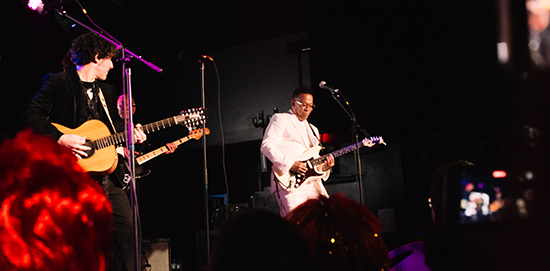
HILOBROW: I really related to what you were saying about retroactively thinking of some songs with the arrangements they had in-concert, like all the horns on the Serious Moonlight Tour. I so love all of those arrangements, and I always thought — yes, I wasn’t the biggest fan of Let’s Dance as an album, but once I went to the show I thought, wow, I would’ve been happy with them just bringing out this tour as the album. I also always felt that those versions, which were so upbeat and refreshed, of even some of his darkest stuff, seemed to be more a fulfillment of what he would tell interviewers he was trying to do with the album, in terms of being more “positive.” Is that maybe the reason why he got you back for the tour, because you were the bridge between those eras?
ALOMAR: Na, we don’t complicate stuff like that. It’s not that philosophical, it’s like, “I need Carlos, ’cuz Carlos does his job. And I need horn arrangements and I don’t know what the hell I’m doing, so come over here and take care of this stuff for me.” Did I do Let’s Dance? No. They wouldn’t pay me the right money, and disrespected me in a way. Did I care? No; I went on and I did two other albums, no big deal. But then David calls me [himself]; “Hey Dave, what’s up? Okay, I’ll be right there.”
HILOBROW: So those arrangements were all yours?
ALOMAR: Those are with the Borneo Horns; Stan Harrison, Steve Elson and Lenny Pickett and I worked those arrangements out. The most important thing for me was, because I was doing arrangements for the Let’s Dance [songs], these horns now had to come into old Bowie songs; even “Fame” had to have a revisit. So that challenge for me was awesome. As an arranger, you really want something that will demonstrate the possibilities of what you’re given. “Oh, I’ve got five background vocals? Okay, what can I do with that. I got three horns? Lemme see, I always wanted some horns. Two synthesizer players and a violin, what the hell am I supposed do with that?” These — again, another saying that Bowie gave me, “There are no problems, there are only challenges.” And he also told me, “Let go or be dragged.” So, constantly having to redo things and relook at them and revisit them, and then apply everything you’ve learned to a new way of doing it? Man, that’s awesome! Anybody would, given the opportunity, jump right in there and show what they got. True grit. Just go in there and polish it off and deliver it good.
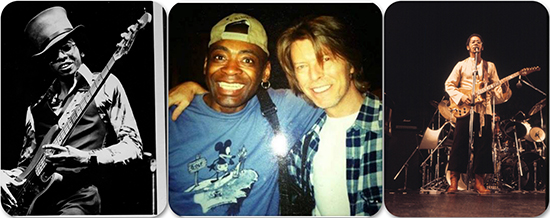
HILOBROW: I went online and finally found a rehearsal tape of how “Joe the Lion” would’ve sounded on the Serious Moonlight Tour, and that was amazing too — these are some of the most depressing and bleak songs and you managed to make them both upbeat and still edgy.
ALOMAR: I wanna go on tour just to demonstrate what I call the D.A.M. Trio trilogy [Davis/Alomar/Murray, renowned for the bleeding-edge art-pop sides of Bowie & Eno’s “Berlin trilogy”]. I mean I love the Brian Eno stuff, but I want people to really understand, I don’t want the slow stuff, I want the stuff that’s gonna make you go home with a pounding heartbeat, like, “Am I gonna make it?” [laughs] I want that. So if I can do a tour that demonstrates the other part of it, the hardness of the D.A.M. Trio, that’s what I wanna do. Rebrand that trilogy.
It makes logical sense. We reflect on the possibilities of what could be, and there are certain aspects that we forget: technology. You can only do so much on a [vinyl] record that gives you 42 minutes of pressing. Now there’s a CD, I have more capacity, I can do more…soundscapes. Bowie doing that then was amazing; now, I could press one button on a computer. The advent of all of this technology does not mean that the human spirit is not the engine behind it. The human spirit must be the engine behind it. That is the engine that drives the force of music that pounds your heart. It is the lyrics, and the essence of the storyteller, that must shine through. David Bowie was a hell of a storyteller. And even if you didn’t like it, like bad medicine, you’re gonna swallow some intelligence and some information; “I’m gonna give you some landmark places that you don’t even know they exist, why don’t you go open up an encyclopedia or an atlas and find…” —THIS is the kind of intelligence that a storyteller like Bowie could impose on an audience. To a young adult? That could be like everything. What young teenager speaks to intellectuals? Answer: none. So if you get some words of wisdom from Bowie, hell man, that’s better than a lot of people I know.
Photos (top to bottom): Showing how it’s done (carlosalomar.com/Stevens); Carlos makes his point (w/ l-r, Pegg, Clark, and Rojas; photo: Rishika Nath); Serious Moonlighting, c. 1983; Carlos cuts loose at Bowie Ball 2023 (photo: Rishika Nath); the D.A.M. Trio remembered (l-r Murray, Davis, Some Guy, and Alomar; carlosalomar.wordpress.com)
MORE POSTS by ADAM McGOVERN: OFF-TOPIC (2019–2024 monthly) | textshow (2018 quarterly) | PANEL ZERO (comics-related Q&As, 2018 monthly) | THIS: (2016–2017 weekly) | PEOPLE YOU MEET IN HELL, a 5-part series about characters in McGovern’s and Paolo Leandri’s comic Nightworld | Two IDORU JONES comics by McGovern and Paolo Leandri | BOWIEOLOGY: Celebrating 50 years of Bowie | ODD ABSURDUM: How Felix invented the 21st century self | KOJAK YOUR ENTHUSIASM: FAWLTY TOWERS | KICK YOUR ENTHUSIASM: JACKIE McGEE | NERD YOUR ENTHUSIASM: JOAN SEMMEL | SWERVE YOUR ENTHUSIASM: INTRO and THE LEON SUITES | FIVE-O YOUR ENTHUSIASM: JULIA | FERB YOUR ENTHUSIASM: KIMBA THE WHITE LION | CARBONA YOUR ENTHUSIASM: WASHINGTON BULLETS | KLAATU YOU: SILENT RUNNING | CONVOY YOUR ENTHUSIASM: QUINTET | TUBE YOUR ENTHUSIASM: HIGHWAY PATROL | #SQUADGOALS: KAMANDI’S FAMILY | QUIRK YOUR ENTHUSIASM: LUCKY NUMBER | CROM YOUR ENTHUSIASM: JIREL OF JOIRY | KERN YOUR ENTHUSIASM: Data 70 | HERC YOUR ENTHUSIASM: “Freedom” | KIRK YOUR ENTHUSIASM: Captain Camelot | KIRB YOUR ENTHUSIASM: Full Fathom Five | A 5-part series on Jack Kirby’s Fourth World mythos | Reviews of Annie Nocenti’s comics Katana, Catwoman, Klarion, and Green Arrow | The curated series FANCHILD | To see all of Adam’s posts, including HiLo Hero items on Lilli Carré, Judy Garland, Wally Wood, and others: CLICK HERE
